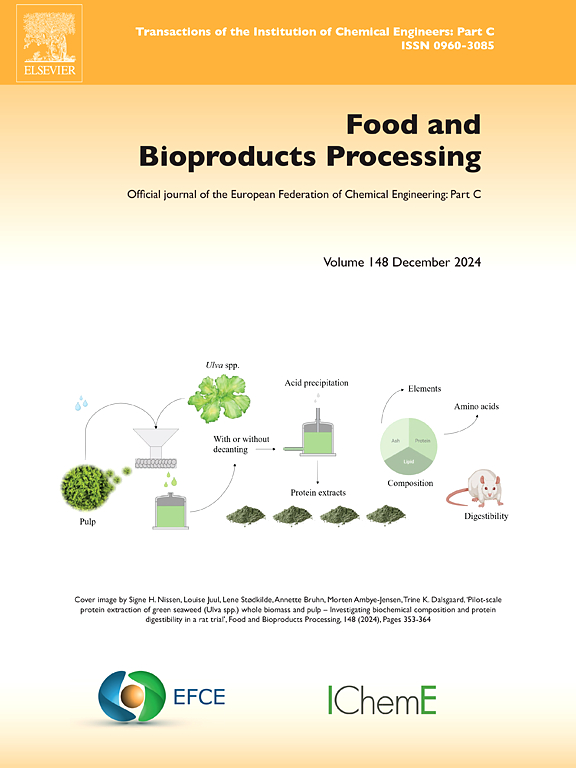食品种类、托盘壁面装载、溜槽长度对冷藏拖车货物温度非均质性的影响
IF 3.4
2区 农林科学
Q2 BIOTECHNOLOGY & APPLIED MICROBIOLOGY
引用次数: 0
摘要
食品的拖车冷藏运输是冷链的重要组成部分。主要的挑战是将产品保持在所需的温度范围内,以保持其适销性并确保食品安全。托盘通常靠墙放置,影响气流和冷却效率,导致不理想的储存温度。我们使用基于物理的模拟和计算流体动力学来探索非壁面装载、半壁面装载和壁面装载如何影响货物内部的温度分布。我们研究了三种情况:包装生菜、冷却巧克力和冷冻肉,以及全滑槽、半滑槽和无滑槽的影响。结果表明,交替托盘布置显著改善了气流均匀性和冷却性能,在72 h后,生菜的平均温度降低了0.8°C,巧克力的平均温度降低了0.2°C。生菜受墙负荷的影响最小,而巧克力在供气为14℃时,由于导热系数低,在靠近墙的地方显示出15℃的局部温暖区域。冻肉最容易变暖,近壁温度超过- 18°C,受托盘高度低、热扩散率低以及比其他情况高两倍的外部-内部温度梯度的影响。缩短的溜槽增加了温度的不均匀性,使拖车门端托盘排平均温度升高3℃。尽管有更好的冷却交替托盘安排,墙壁接触应尽量减少,以避免局部温暖的地方。我们的研究结果主张避免壁面加载以提高温度均匀性和冷链效率。本文章由计算机程序翻译,如有差异,请以英文原文为准。
The impact of food type, wall-loading of pallets, and chute length on cargo temperature heterogeneity of refrigerated trailers
Refrigerated transport of food products in trailers is a crucial part of the cold chain. The main challenge is to keep the products within the desired temperature range to maintain their salability and ensure food safety. Pallets are typically positioned against the wall, affecting airflow and cooling efficiency, leading to suboptimal storage temperatures. We use physics-based simulations and computational fluid dynamics to explore how non-wall-loading, semi-wall-loading, and wall-loading affect the temperature distribution within the cargo. We examine three cases: packaged lettuce, cooled chocolate, and frozen meat, and the effects of a full, half-length, and no chute. Results indicate that alternating pallet arrangements significantly improve airflow uniformity and cooling performance, reducing average temperatures after 72 h by over 0.8 °C for lettuce and 0.2 °C for chocolate compared to non-wall and wall-loading configurations. Lettuce is least affected by wall loading, while chocolate shows localized warm areas with 15 °C near the wall when supply air is at 14 °C, due to low thermal conductivity. Frozen meat is most susceptible to warming, with near-wall temperatures exceeding −18 °C, influenced by low pallet height, low thermal diffusivity, and a by factor two higher external-internal temperature gradient than the other cases. A shortened chute increases temperature heterogeneity and raises mean trailer door-end pallet row temperature by up to 3 °C. Despite better cooling with alternating pallet arrangements, wall contact should be minimized to avoid local warmer spots. Our results advocate avoiding wall loading to enhance temperature uniformity and cold chain effectiveness.
求助全文
通过发布文献求助,成功后即可免费获取论文全文。
去求助
来源期刊

Food and Bioproducts Processing
工程技术-工程:化工
CiteScore
9.70
自引率
4.30%
发文量
115
审稿时长
24 days
期刊介绍:
Official Journal of the European Federation of Chemical Engineering:
Part C
FBP aims to be the principal international journal for publication of high quality, original papers in the branches of engineering and science dedicated to the safe processing of biological products. It is the only journal to exploit the synergy between biotechnology, bioprocessing and food engineering.
Papers showing how research results can be used in engineering design, and accounts of experimental or theoretical research work bringing new perspectives to established principles, highlighting unsolved problems or indicating directions for future research, are particularly welcome. Contributions that deal with new developments in equipment or processes and that can be given quantitative expression are encouraged. The journal is especially interested in papers that extend the boundaries of food and bioproducts processing.
The journal has a strong emphasis on the interface between engineering and food or bioproducts. Papers that are not likely to be published are those:
• Primarily concerned with food formulation
• That use experimental design techniques to obtain response surfaces but gain little insight from them
• That are empirical and ignore established mechanistic models, e.g., empirical drying curves
• That are primarily concerned about sensory evaluation and colour
• Concern the extraction, encapsulation and/or antioxidant activity of a specific biological material without providing insight that could be applied to a similar but different material,
• Containing only chemical analyses of biological materials.
 求助内容:
求助内容: 应助结果提醒方式:
应助结果提醒方式:


